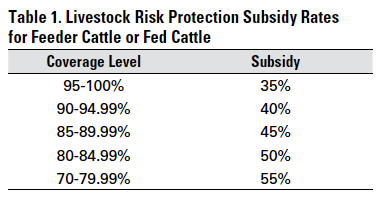Navigating Service Risks with Bagley Risk Management
Navigating Service Risks with Bagley Risk Management
Blog Article
Understanding Livestock Danger Security (LRP) Insurance Coverage: A Comprehensive Guide
Browsing the world of animals risk protection (LRP) insurance can be an intricate undertaking for many in the farming market. From how LRP insurance coverage operates to the numerous protection alternatives readily available, there is much to uncover in this detailed overview that might possibly form the means animals manufacturers approach risk administration in their services.

Just How LRP Insurance Policy Functions
Sometimes, recognizing the mechanics of Livestock Danger Defense (LRP) insurance policy can be complex, however breaking down how it works can provide quality for herdsmans and farmers. LRP insurance policy is a risk monitoring device made to protect animals manufacturers versus unforeseen cost decreases. It's crucial to keep in mind that LRP insurance coverage is not an earnings warranty; rather, it concentrates entirely on price risk protection.
Eligibility and Coverage Options

When it involves protection choices, LRP insurance policy offers manufacturers the adaptability to choose the coverage level, protection duration, and recommendations that ideal match their threat management demands. Protection degrees generally range from 70% to 100% of the anticipated finishing value of the insured livestock. Manufacturers can also choose coverage periods that line up with their production cycle, whether they are insuring feeder cattle, fed livestock, swine, or lamb. Recommendations such as rate threat defense can better personalize insurance coverage to secure versus adverse market variations. By comprehending the qualification criteria and protection alternatives offered, livestock manufacturers can make enlightened decisions to take care of threat properly.
Advantages And Disadvantages of LRP Insurance Policy
When reviewing Animals Risk Defense (LRP) insurance coverage, it is crucial for animals manufacturers to consider the advantages and disadvantages inherent in this risk administration tool.

One of the main benefits of LRP insurance policy is its ability to supply defense versus a decrease in animals rates. In addition, LRP insurance coverage offers a degree of adaptability, enabling manufacturers to customize coverage degrees and policy periods to fit their details requirements.
Nonetheless, there are also some downsides to take into consideration. One limitation of LRP insurance coverage is that it does not secure versus all kinds of threats, such as illness outbreaks or all-natural disasters. Costs can in some cases be pricey, especially for manufacturers with big livestock herds. It is essential for manufacturers to thoroughly evaluate their private threat direct exposure and monetary circumstance to identify if LRP insurance coverage is the best risk monitoring tool for their operation.
Recognizing LRP Insurance Coverage Premiums

Tips for Taking Full Advantage Of LRP Advantages
Taking full advantage of the benefits of Animals Danger Protection (LRP) insurance coverage needs strategic planning and aggressive this hyperlink risk management - Bagley Risk Management. To maximize your LRP insurance coverage, consider the complying with tips:
On A Regular Basis Evaluate Market Problems: Keep notified concerning market patterns and rate variations in the livestock sector. By monitoring these aspects, you can make educated choices about when to purchase LRP coverage to secure against possible losses.
Establish Realistic Protection Degrees: When choosing protection levels, consider your production expenses, market value of animals, and possible risks - Bagley Risk Management. Establishing realistic protection levels makes sure that you are sufficiently safeguarded without overpaying for unnecessary insurance policy
Expand Your Coverage: As opposed to counting only on LRP insurance policy, think about diversifying your risk monitoring strategies. Incorporating LRP with various other risk management tools such as futures agreements or options can provide extensive insurance coverage versus market unpredictabilities.
Evaluation and Change Insurance Coverage Regularly: As market problems change, regularly examine your LRP insurance coverage to guarantee it aligns with your present threat exposure. Readjusting protection levels and timing of purchases can aid enhance your threat protection technique. By following these pointers, you can optimize the benefits of LRP insurance policy and safeguard your animals operation versus unanticipated dangers.
Conclusion
In verdict, animals threat defense (LRP) insurance coverage is a beneficial tool for farmers to handle the financial dangers related to their animals procedures. By understanding exactly how LRP works, qualification and protection choices, as well as the advantages and disadvantages of this insurance coverage, farmers can make enlightened choices to safeguard their source of incomes. By very carefully considering LRP premiums and applying approaches to make the most of benefits, farmers can mitigate potential losses and guarantee the sustainability of their procedures.
Livestock producers interested in acquiring Animals Risk Defense (LRP) insurance coverage can explore an array of eligibility standards and coverage options tailored to their specific animals operations.When it comes to insurance coverage options, LRP insurance policy uses manufacturers discover here the adaptability to pick the insurance coverage level, coverage duration, and recommendations that best fit their threat monitoring demands.To understand the intricacies of Livestock Risk Defense (LRP) insurance coverage totally, comprehending the factors influencing LRP insurance coverage premiums is critical. LRP insurance policy premiums are determined by different elements, consisting of the coverage level chosen, the expected cost of livestock at the end of the coverage duration, the type of livestock being guaranteed, and the size of the protection duration.Review and Change Insurance Coverage On a regular basis: As market conditions transform, periodically evaluate your LRP protection to guarantee it lines up with your current risk direct exposure.
Report this page